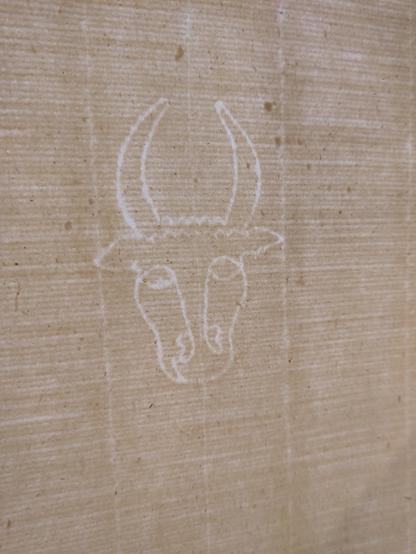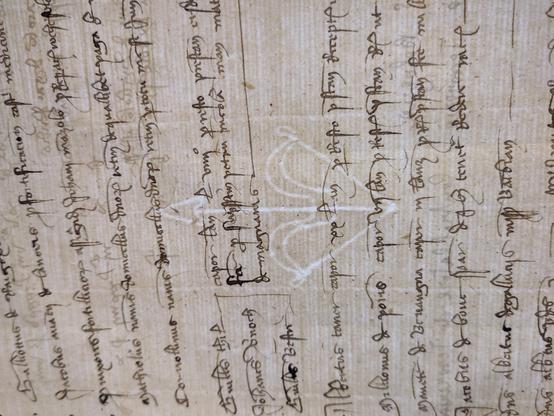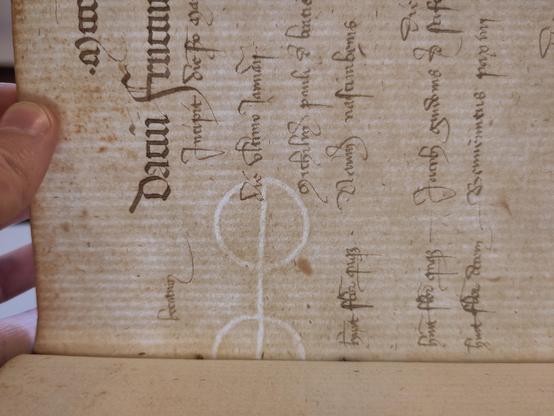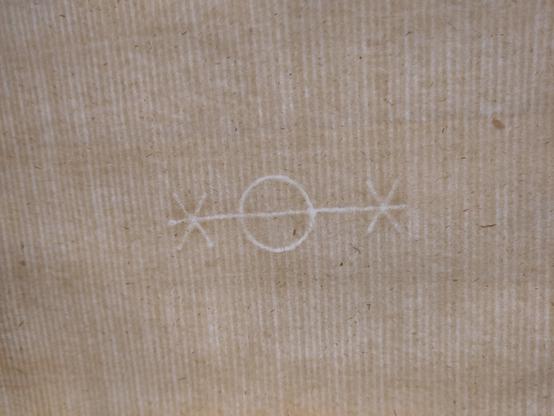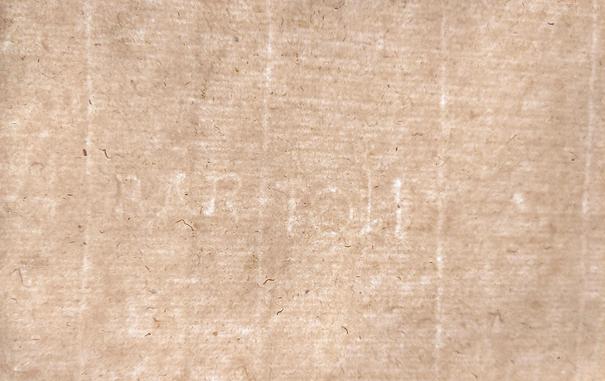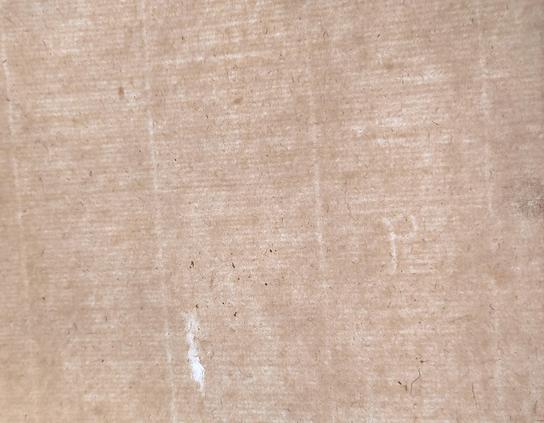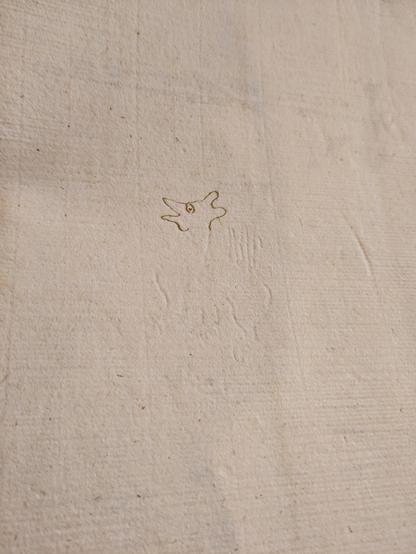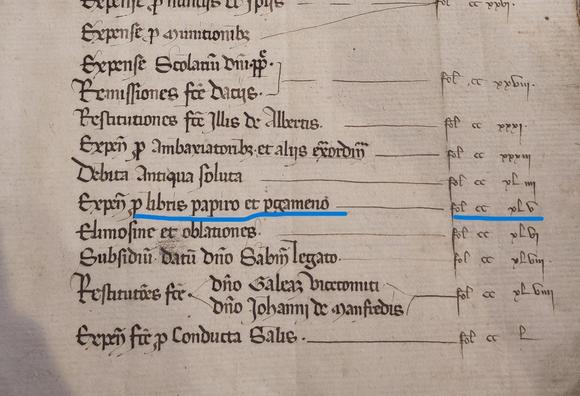📝 Lost in comptabilité (1)
Un nouveau billet sur mon carnet Hypotheses, où j'essaie d'expliquer pourquoi les comptabilités sont une source passionnante... notamment pour comprendre les grandes transformations de l'écrit et de l'administration à la fin du Moyen Âge.
#paperhistory
Une belle moisson de filigranes aujourd'hui (mais pas de 🐟...)
#paperhistory
Pour la première fois, j'ai retrouvé un filigrane pour lequel j'ai la certitude de la provenance : BARTOLI P., un papetier de Fabriano du début du XIVe siècle, bien attesté dans la documentation.
Bon, Fabriano étant la principale ville productrice de papier à l'époque en Italie, rien de très surprenant. Mais ça fait plaisir de voir ce type de filigrane - les noms des papetiers eux-mêmes - sur lequel j'avais lu les articles de Jean Irigoin...
https://www.brepolsonline.net/doi/abs/10.1484/M.BIB-EB.3.4849
📝 Un nouveau billet : “Ici se trouvent des dragons” 🐉
Où je tente des trucs, en recoupant des filigranes et les comptes des administrations financières de Bologne pour comprendre comment celles-ci s'approvisionnent en papier.
Un peu technique, mais j'ai essayé de me mettre des idées au clair sur un petit corpus test.
Et puis, ya de jolis dragons...
Les notaires de la Trésorerie de Bologne trouvaient aussi que leurs filigranes étaient mignons 🤭🐉
Drame en 3 actes :
I. Houla, il a l'air tout abîmé ce registre de comptes de la Trésorerie de Bologne (1365)
II. Yeah, la table des matières dit qu'il y a une entrée sur les dépenses de papier et parchemin ! Allons voir au folio 245.
III. Les folios après le folio 242 ont été perdus 😭
📝 Un nouveau billet de mon carnet Hypotheses : Migrants tous azimuts
Où on parle de gens qui bougent et qui continueront probablement encore de bouger... au XVe siècle en Italie, comme ailleurs.
J'ai fait le point sur les archives et la biblio que j'ai sur la circulation des métiers du livre en Italie du Nord aux XIVe-XVe siècle.
Conclusion : ça bouge partout, tout le temps, dans tous les sens. Des Bolognais qui vont s'installer à Padoue, des Milanais qui vont s'installer à Brescia, des Florentins qui viennent s'installer à Bologne, et des Allemands dans le tas qui se baladent...
Pas sure que j'en tirerai une conclusion plus intéressante que ça, mais en tout cas, c'est assez impressionnant comme mobilités croisées....
#bookhistory #paperhistory
📝 En préparation d'un séminaire pour la semaine prochaine, un petit billet sur mon carnet Hypotheses sur un document trouvé aux archives de Bologne et qui m'a ouvert toute une série de perspectives...
Un document passé à la loupe : le moulin de Raynaldus en une page.
Félix Vallotton, L’âge du papier. Dessin pour « Le Cri de Paris », 1898
#paperhistory
Bei bibliotheca.gym erscheint ab morgen, den 1. Dezember 2024, wieder ein Adventskalender mit 24 Beispielen aus historischen Schulbibliotheken zur "äußeren Pracht" der Bücher:
https://histgymbib.hypotheses.org/23579
#earlymodern #kulturgut #histodons #Buchgeschichte #paperhistory #bildung
Today, the painting that imagined a typical working scene of a celebrity scientist that was educated in #Oxford, lived in #Paris and died in #Cologne, can be found here:
https://digital.bodleian.ox.ac.uk/objects/d361c90c-1cdd-441f-b207-f83a6a5e6472/#
So what paper could he possibly have used around 1300 in Oxford, Paris or Cologne? We know that the artifact 'paper' was introduced and produced in Europe first by Arab papermakers and via Arab trade contacts from the eleventh and twelfth centuries.
2/3
The man copying a few lines from an open book onto a fresh sheet of paper was a well-known Franciscan friar: John Duns Scotus who lived between 1265-1308. The paper user on this painting is one of the important philosopher-theologians of Europe, dear #histodons.
But what paper was available around 1300 in Europe? Is the paper usage imagined on this painting that was done about 300 years after his death. Follow me for more...
A thread for those interested in #PaperHistory #BookHistory
1/3
There is a paper story in this painting from 1672: welcome to the shortest thread for #paperhistory in one post only (plus much more details in the alt-text)
1 - a paper letter (being moved)
2 - used paper sheets (messy)
3 - a document bag! (fun)
4 - stored paper sheets (waiting)
5 - waste paper (lying around)
So, blue paper people, this volume just dropped: "Venice in Blue: The Use of carta azzurra in the Artist's Studio and in the Printer's Workshop, ca. 1500-1550", ed. by A. McCarthy, L. Moretti, and P. Sachet
https://www.olschki.it/libro/9788822269096
#paperhistory #histodons #earlymodern #bluepaper #arthistory
Drawn to Blue
An online symposium, co-organized by the J. Paul Getty Museum and the University of Amsterdam, bringing together art historians and paper and textile conservators to share research on the history of #earlymodern blue paper. #paperhistory #bookhistory #histodons #bluepaper
To sum up: Early modern Europe was a paper age. And we find traces of this beginning paper using culture in Europe reflected within the arts. #PaperHistory
is one way to access and explore #earlymodern #bookhistory
6/6
You surely know the painting "Ecce Homo" from Andrea Mantegna, made around the year 1500. However, there is a small paper story included. A short thread for friends of #PaperHistory, dear #histodons
1/6
What should I write next?
The first two topics I covered for my stationery in Sherlock Holmes series were the ones that most interested me: notebooks & the index.
Which topic should I choose next? (Please keep in mind that this is a long-term and intermittent series; it may be some time before the next post goes up.)
https://fromtherostra.com/2023/10/20/sherlockian-stationery-part-1-notebooks/
https://fromtherostra.com/2024/02/06/sherlockian-stationery-part-2-the-index/
#prewriting #SherlockHolmes #stationery #history #19c #PaperHistory #ArthurConanDoyle #WrittenCommunication
He who pays the piper calls the tune. The pocket #viola might remember us: Writing and publishing (on paper) are part of a human power struggle, and depend on financial support.
Also: Reader of the painting, be reminded: do enjoy writing and printing on paper. Have fun, find your writing tune.
#histodons #bookhistory #newshistory #paperhistory #history #arthistory
